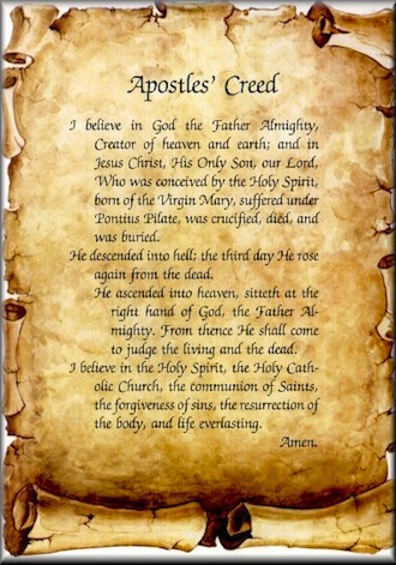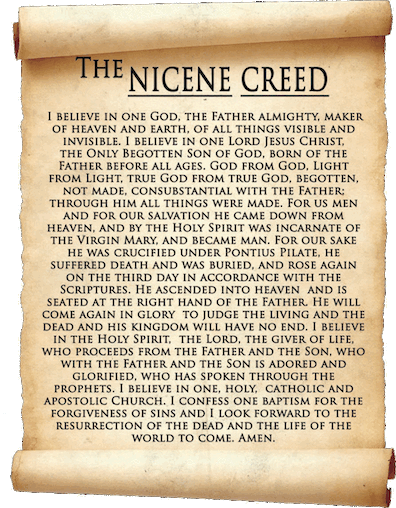Ithaca names "four separating forces" between Bloom
and Stephen: "Name, age, race, creed." Although the word is
used loosely there as a mere synonym for religion, in a
narrower and stricter sense a creed is a formal statement of
religious doctrines. Stephen thinks respectfully of two
ancient Christian creeds in Telemachus, but he is no
longer a believer and in Scylla and Charybdis he
subjects one of them, the Apostles' Creed, to mockery.
Someone in the crowd of young men at the end of Oxen of
the Sun wittily captures the contradiction: "Parson
Steve, apostates' creed!"
Haines's questioning prompts Stephen to identify one of his
two overbearing "masters" as “the holy Roman catholic and
apostolic church.“ Except for the word Roman, these "proud
potent titles" come from the most widely accepted Christian
creed, the 4th century Nicene Creed, as Stephen thinks a
moment later: “et unam sanctam catholicam et
apostolicam ecclesiam.” Immediately after, he
thinks of the "Symbol of the apostles." The Symbolum
Apostolicum or Symbolum Apostolorum, also known
as the Apostles' Creed, is the earliest known Christian creed,
formulated in the late 2nd and early 3rd centuries. The Nicene
Creed followed its general outlines, repeating many of its
phrases while significantly expanding it.
Creeds begin with the Latin word Credo, "I
believe." The Greek term symbolon, which referred to a
physical object signifying agreement between individuals, was
sometimes used as a synonym. These formulations of belief were
designed to define correct belief (orthodoxy) and distinguish
it from false teachings (heresy). As Stephen acknowledges when
he thinks of "the slow growth and change of rite and
dogma," orthodox Christian doctrine developed
gradually over the course of time as church authorities chose
among competing accounts of the revealed truth, meeting in
committees over the course of decades to hammer out perfectly
correct language. One particular kind of wordsmithing lay
behind the Nicene Creed; it was formulated to counter the
teachings of Arius,
by articulating a particular conception of the relation
between Father and Son. This creed's "proud potent titles"
soon send Stephen’s thoughts into a triumphal fantasy of the
archangel Michael casting out a flock of heretics, Arius among
them.
Stephen associates the evolution of orthodox belief with the
evolution of "his own rare thoughts, a chemistry of stars,"
and the analogy is not fortuitous. Having renounced his
allegiance to the Catholic church but not his affection for
the church's intricate intellectual structures, he is engaged
in appropriating Christian symbols and doctrines for use in
his fiction. Richard Ellmann says of Joyce in his young adult
years, "Christianity had subtly evolved in his mind from a
religion into a system of metaphors, which as metaphors could
claim his fierce allegiance. His brother Stanislaus's outward
rebellion, which took the form of rudeness to his masters at
Belvedere and defiance at home—his atheism worn like a
crusader's cross—did not enlist James's sympathy. He preferred
disdain to combat. He was no longer a Christian himself; but
he converted the temple to new uses instead of trying to knock
it down, regarding it as a superior kind of human folly" (66).
In Telemachus Stephen thinks of heretical offenses
against the doctrine of consubstantiality enshrined in
the Nicene Creed, in the process labelling Mulligan a heretic, because he
is working out an understanding of artistic creation inspired
by the relationship between father and son in Shakespeare's Hamlet––a
theory which Mulligan likes to mock. Scylla and Charybdis
shows Stephen lecturing on his vision of artistic
consubstantiality, but it also suggests his disbelief in the
Christian version. When Mulligan enters the library office,
Stephen thinks of "Johann Most," a
German-American anarchist who parodied the Apostles' Creed in
a 1902 pamphlet titled Deistic Pestilence:
A Godly Charlatan who created himself through the
Holy Ghost, and then sent himself a mediator between himself
and others, and who, held in contempt and derided by his
enemies, was nailed to a cross, like a bat to a barndoor; who
was buried, arose from the dead, descended to Hell, ascended
to Heaven, and since then for eighteen hundred years has been
sitting at his own right hand to judge the living and the dead
when the living have ceased to exist.
Stephen recalls Most's parody precisely, thoroughly, and with
warmly inventive touches of his own:
He Who Himself begot middler the Holy Ghost and
Himself sent Himself, Agenbuyer, between Himself and
others, Who, put upon by His fiends, stripped
and whipped, was nailed like bat to barndoor, starved on
crosstree, Who let Him bury, stood up, harrowed
hell, fared into heaven and there these nineteen hundred
years sitteth on the right hand of His Own Self but yet shall
come in the latter day to doom the quick and dead when all the
quick shall be dead already.
The flood of mocking absurdities is triggered by thoughts
like those that Stephen indulged in Telemachus, when
he associated Mulligan with theologians who questioned the
doctrine of consubstantiality: "Brood of mockers: Photius,
pseudomalachi, Johann Most." And like those heretical
theologians (Arius, Valentinus, Photius, and especially
Sabellius), Most's blasphemous conceit takes aim at the notion
that Father and Son are distinct, equal entities. But
Stephen's recollection of Most's sentence shows him mocking
Christian doctrine, just like Mulligan. Artistic
consubstantiality is one thing, it seems, and theology quite
another. After the long hour in Oxen of the Sun in
which he heaps far more mockery on Christian teachings, the
medical students hail Stephen's subversion of church language:
"Parson
Steve, apostates' creed!"


